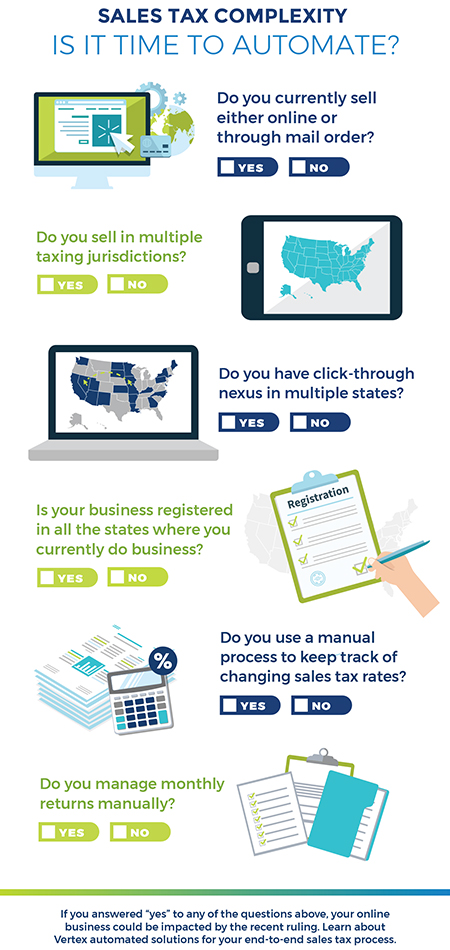Get Ready to Automate
New Tax Legislation Empowers States to Collect Sales Tax from Remote Sellers
As digital transformation efforts continue to advance, there’s never been a greater need for powerful, scalable, and integrated data management capabilities. While this is the case throughout the enterprise, it is especially relevant for people in corporate tax functions within retail companies that are selling in the US following the momentous US Supreme Court decision in June 2018. The South Dakota v. Wayfair ruling allows US states to require remote sellers to collect sales and use tax on out-of-state transactions if they reach certain economic nexus thresholds. This decision has most states scrambling to create, finalize, and implement online sales tax collection requirements that had either been in legal limbo or did not exist prior to the Court’s historic decision.
The Wayfair ruling’s ripple effects will place new demands on how companies manage, calculate, and report tax data. Other disruptions, including real-time sales tax remittance requirements, also contribute to an intensifying need for tighter integration between tax management and financial management technology, swift implementations of sales tax automation applications, and scalable tax and financial management technology. Let’s take a closer look at the implications of the Wayfair ruling.
Wayfair and Digital Taxation Challenges
The Wayfair ruling has prompted a flurry of activity among numerous states eager to begin taxing remote transactions conducted by out-of-state sellers that did not previously collect and remit sales tax. While some larger online retailers have collected and remitted sales tax for some time, many other companies that sell online or through catalog or phone orders did not. These organizations face new compliance and tax data management challenges.
Explore related questions
States generally have been quick to react to the Wayfair ruling; several already have issued updates. While specific facets of these statutes differ (for example, the gross revenue and transaction volume thresholds sellers must exceed to be required to comply), most of the rules require changes to existing tax collection and remittance processes. A handful of new rules likely will begin taking effect within the next few months; many more states plan to release updates in the next six to 12 months.
These changes can be significant for tax functions whose companies sell remotely into jurisdictions that are not currently collecting and reporting taxes. The challenges will be more severe for organizations that do not have sales tax software in place or have not recently updated their supporting technology. As such, tax functions in organizations potentially affected by the Wayfair decision should:
- Start gathering data on gross revenues and the number of transactions that occur within states where the company sells remotely
- Prioritize states where the company has the greatest economic presence and create a plan to register to collect and remit sales tax (for example, via a marketplace or with a hosted or cloud-based technology solution)
- Evaluate the financial statement impact of remote seller compliance
- Review invoicing processes and controls to avoid significant customer dissatisfaction and cash flow risks
Other tax data management challenges also lurk. More global tax jurisdictions are implementing real-time tax submission requirements and the trend appears to be gaining momentum. Hungary recently joined Spain as one of a growing number of European Union countries that require some form of real-time value added tax (VAT) invoice submissions for certain transactions. In the US, some states have also begun considering real-time sales tax remittance requirements. In 2013, Connecticut considered requiring delinquent sales tax payers to automatically remit sales tax to its department of revenue at the point of sale. In 2018, legislators in Massachusetts and Arizona either considered or requested studies on real-time sales tax collection and remittance requirements. (To see if your company could be affected by the South Dakota v. Wayfair ruling, take the quiz at the end of this article.)
Integration Equals Less Time, Greater Accuracy, and Faster ROI
Rapidly changing external compliance requirements combined with digital transformation and ongoing cloud-migration efforts are reshaping the tax function’s technology needs. When tax and IT professionals evaluate new investments in tax technology, they express a growing need for:
- Reduced time and effort to perform sales and use tax calculations
- Greater accuracy of calculations and compliance data
- Faster user adoption with anytime, anywhere accessibility
- Scalability to meet businesses’ changing sales and use tax requirements
- Extended functionality for all types of businesses across the globe
- Support for sales tax, consumer use tax, and VAT across the globe
- Faster implementation, higher return on investment (ROI), greater ease of security, and lower total cost of ownership (TCO)
Integrating tax solutions within ERP systems and other business application tools can address these needs. When tax management applications, such as Vertex Cloud, smoothly plug into ERP systems that store both transactional and analytical data, tax functions can more easily run real-time analyses, streamline tax calculation and compliance, and reduce tax compliance risks. Vertex also provides seamless integration with SAP S/4HANA Cloud and SAP Commerce Cloud to ensure organizations stay compliant.
Learn More
Given the high number of new sales tax requirements expected to materialize in dozens of states, there has never been a greater need for automated tax technology. SAP and Vertex are working together to provide solutions to challenges posed by Wayfair — delivering an enhanced and certified cloud solution, as well as easing the burden for organizations to rapidly meet compliance needs in an ever-changing regulatory climate. Integration with SAP solutions enables organizations to access Vertex indirect tax solutions — which support accurate, automated sales and use tax calculations, as well as signature-ready returns — from the SAP App Center, equipping tax functions with the simpler and speedier implementation timeline that sales tax changes necessitate. Click here to learn more about the potential impact of the South Dakota v. Wayfair.






